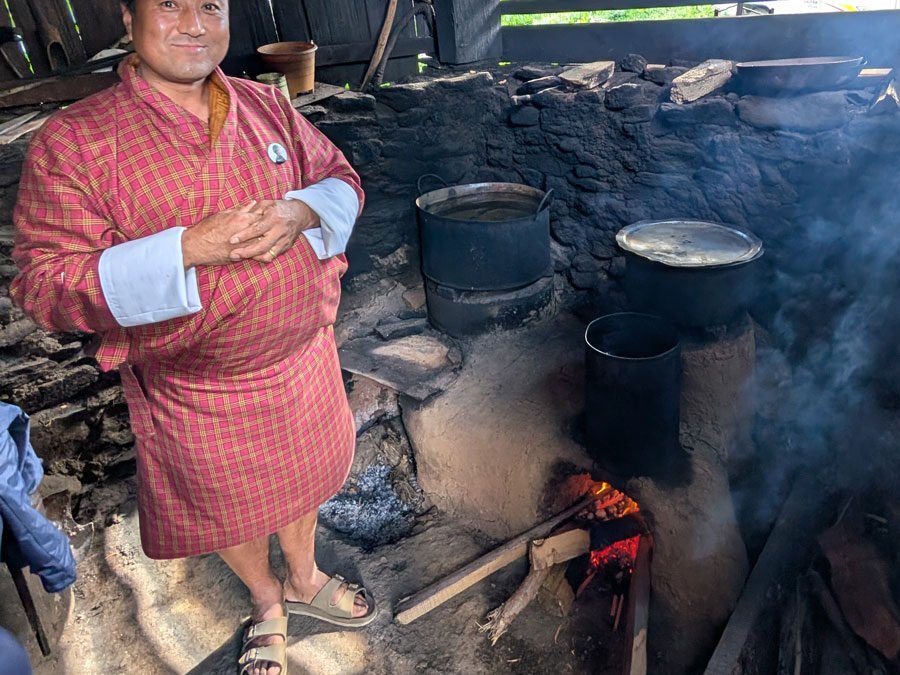At Himalayan Rocket Stove (HRS), we’re always innovating to meet the unique needs of communities across the Himalayas. Our original Smokeless Cookstove Rocket (SCR) design, detailed in our [step-by-step construction guide](https://himalayanrocketstove.com/scr-steps/), has been a game-changer for clean cooking and heating. Built using a simple clay recipe and stacked “donuts” with a 5-inch (125mm) internal diameter hole and 3-inch (75mm) thick walls, it promotes efficient wood burning, reducing smoke and fuel consumption. But as we’ve expanded our work, particularly in Bhutan, we’ve encountered new challenges—and opportunities—for adaptation.
In Bhutan, where livestock farming is a cornerstone of rural life, farmers often need to heat large quantities of cow feed. This might involve boiling or warming mash made from grains, vegetables, and other biomass to make it more digestible and nutritious for cattle, especially during the cold winters. Traditional open fires or basic stoves for this task are inefficient: they produce heavy smoke that harms health and the environment, and they guzzle wood, contributing to deforestation in sensitive Himalayan ecosystems.
Enter our scaled-up SCR versions. Drawing directly from the foundational steps in our guide, we’ve modified the design to incorporate larger internal tube diameters—8 inches, 10 inches, and 12 inches—to accommodate bigger pots and higher heat output. This allows for heating substantial volumes of cow feed without compromising the rocket stove’s core principles of clean, efficient combustion. Here’s how we’re doing it and why it’s making a real difference.
Adapting the Original SCR Design for Larger Scale
Our standard SCR starts with a straightforward clay mixture: 4 parts local clay powder, 1-2 parts dry cut grass (about 3 inches long) for binding, 1-2 parts puffed rice or grain for lightness and insulation, and water mixed in until it reaches a chapati-dough consistency. From there, you form 5 clay “donuts” with a central hole and thick walls, sketching parallel lines to guide assembly (as outlined in Steps 1 and 2 of the guide here).
For the larger versions:
1. Increase the Hole Diameter**: Instead of the original 5-inch hole, we now create donuts with 8-inch, 10-inch, or 12-inch central openings. This wider combustion chamber allows for bigger fuel loads and better airflow, essential for heating large pots (up to 20-30 liters or more) of cow feed.
2. Scale the Wall Thickness**: To maintain structural integrity and heat retention, we adjust the walls to 4-5 inches thick (100-125mm), depending on the diameter. This prevents cracking under higher temperatures and ensures longevity.
3. Stack More Donuts if Needed**: For taller chimneys in the larger models, we might add 1-2 extra donuts, following the same stacking and alignment process implied in the later steps of the guide (Steps 3-10 focus on building up the structure, smoothing, and curing).
4. Mold and Assembly Tweaks**: Use larger molds to shape the clay donuts consistently. The parallel lines sketched in Step 2 are extended proportionally to guide the fuel inlet and air channels, ensuring the rocket effect—where hot gases are funneled upward for complete burning—remains optimal.
The rest of the construction follows the guide’s progression: building the base, forming the feed tube, and configuring for one-pot or two-pot positions. In Bhutan, we often set these up in a one-pot configuration for simplicity, placing a large cauldron directly over the combustion chamber. For versatility, a two-pot setup can heat feed in one pot while warming water in another.
These adaptations are straightforward for local artisans, using the same low-cost, locally sourced materials. No fancy tools required—just hands, molds, and a bit of patience during the drying process.
The Benefits: Less Smoke, Less Wood, More Sustainability
What makes these larger SCRs truly revolutionary for Bhutanese farmers?
- Dramatic Smoke Reduction: The rocket stove’s design creates a high-temperature burn that consumes smoke-producing particles. Farmers report up to 80% less smoke compared to traditional methods, improving indoor air quality and reducing respiratory issues for families and animals alike.
- Fuel Efficiency: By using less wood—often halving consumption—these stoves ease the pressure on Bhutan’s forests. A 10-inch model, for instance, can heat a full batch of cow feed with just a few branches, versus the armloads needed for open fires.
- Environmental and Economic Wins: Less wood means lower deforestation rates, aligning with Bhutan’s commitment to carbon neutrality. Economically, farmers save time gathering fuel and can redirect efforts to other farm tasks. Plus, the stoves produce biochar as a byproduct (as we’ve discussed in previous posts), which can enrich soil for better crop yields.
We’ve piloted these larger versions in several Bhutanese villages, where they’ve been embraced for their reliability in harsh mountain conditions. One farmer shared, “Heating cow feed used to fill our home with smoke; now, it’s quick, clean, and uses half the wood.”
Looking Ahead
As we continue refining our designs in 2025, we’re excited to share more updates, including potential integrations with solar elements for hybrid heating. If you’re interested in building your own scaled-up SCR, start with our [original guide](https://himalayanrocketstove.com/scr-steps/) and experiment with the larger dimensions—always test in a safe, ventilated space.
At HRS, we’re committed to turning sustainable ideas into practical solutions. Have you tried scaling a rocket stove? Share your experiences in the comments below!
*Posted on August 13, 2025*


Recent Comments